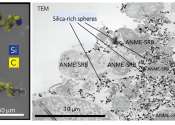The nanoscopic scale usually refers to structures with a length scale applicable to nanotechnology, usually cited as 1-100 nanometers. The nanoscopic scale is roughly speaking a lower bound to the mesoscopic scale for most solids.
For technical purposes, the nanoscopic scale is the size at which the expected fluctuations of the averaged properties due to the motion and behavior of individual particles can no longer be reduced to below some desirable threshold (often a few percent), and must be rigorously established within the context of any particular problem.
The 'nanoscopic scale' is sometimes marked as the point where the properties of a material change; above this point, the properties of a material are caused by 'bulk' or 'volume' effects, namely which atoms are present, how they are bonded, and in what ratios. Below this point, the properties of a material change, and while the type of atoms present and their relative orientations are still important, 'surface area effects', also referred to as quantum effects, become more apparent-these effects are due to the geometry of the material (how thick it is, how wide it is, etc), which, at these low dimensions, can have a drastic effect on quantized states, and thus the properties of a material.









